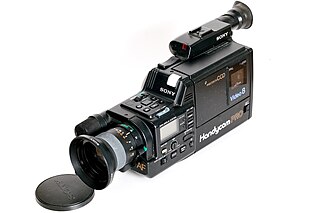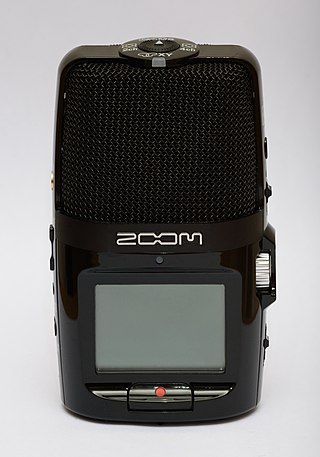Waveform Audio File Format is an audio file format standard, developed by IBM and Microsoft, for storing an audio bitstream on personal computers. It is the main format used on Microsoft Windows systems for uncompressed audio. The usual bitstream encoding is the linear pulse-code modulation (LPCM) format.

MiniDisc (MD) is an erasable magneto-optical disc-based data storage format offering a capacity of 60, 74, and later, 80 minutes of digitized audio.

Digital audio is a representation of sound recorded in, or converted into, digital form. In digital audio, the sound wave of the audio signal is typically encoded as numerical samples in a continuous sequence. For example, in CD audio, samples are taken 44,100 times per second, each with 16-bit sample depth. Digital audio is also the name for the entire technology of sound recording and reproduction using audio signals that have been encoded in digital form. Following significant advances in digital audio technology during the 1970s and 1980s, it gradually replaced analog audio technology in many areas of audio engineering, record production and telecommunications in the 1990s and 2000s.

DV refers to a family of codecs and tape formats used for storing digital video, launched in 1995 by a consortium of video camera manufacturers led by Sony and Panasonic. In the late 1990s and early 2000s, DV was strongly associated with the transition from analog to digital desktop video production, and also with several enduring "prosumer" camera designs such as the Sony VX-1000. DV is sometimes referred to as MiniDV, which was the most popular tape format using a DV codec during this time.

HDV is a format for recording of high-definition video on DV videocassette tape. The format was originally developed by JVC and supported by Sony, Canon, and Sharp. The four companies formed the HDV Consortium in September 2003.

Sound Recorder is an audio recording program included in most versions of the Microsoft Windows family of operating systems. Its user interface has been replaced twice in the past.
The Motorola ROKR, the first version of which was informally known as the iTunes phone, was a series of mobile phones from Motorola, part of a 4LTR line developed before the spin out of Motorola Mobility. ROKR models were released starting in September 2005 and ending in 2009. They were notable for incorporating support of media player features.
The RS Media is another product in WowWee's line of biomorphic robots, based on a walking system designed by Mark Tilden. The RS Media uses basically the same body as the Robosapien V2, but a different brain based on a Linux kernel. As the name implies, the RS Media's focus is on multimedia capabilities, including the ability to record and playback audio, pictures and video. he retains and builds upon the Robosapien V2's sensor array and programmability.

SanDisk has produced a number of flash memory-based digital audio and portable media players since 2005. The current range of products bear the SanDisk Clip name, a line of ultraportable digital audio players. SanDisk players were formerly marketed under the Sansa name until 2014.

Sony Corporation produces professional, consumer, and prosumer camcorders such as studio and broadcast, digital cinema cameras, camcorders, pan-tilt-zoom and remote cameras.

The H2 Handy Recorder is a handheld digital audio recorder from Zoom first announced at the NAMM tradeshow in February 2007. It records very high quality digital stereo or 4-channel audio on a hand-held unit, and has been called "the studio on a stick."

The Sansa Fuze is a portable media player developed by SanDisk and released on March 8, 2008. The Fuze is available in three different Flash memory capacities: 2 GB, 4 GB, and 8 GB and comes in six different colors: black, blue, pink, red, silver, and white. Storage is expandable via a microSDHC slot with capacity up to 32 GB, and unofficially to 64 GB or more via FAT32 formatted SDXC cards. All models have a 1.9 inch TFT LCD display with a resolution of 220 by 176 pixels and a built-in monaural microphone and FM tuner; recordings of the latter two are saved as PCM WAV files.

The Zoom H4n is a digital recording device manufactured by Zoom. It is the successor of the Zoom H4 recorder. Both models have two built-in condenser mics arranged in X/Y stereo position and two XLR microphone inputs that double as 1/4 inch phono jacks for musical instruments. Musical applications for the H4N include the ability to use the device as a multi-track (four-channel) recorder; the device also includes tools like a built-in tuner, metronome and effects processor for line-level instruments like guitars.

The Fujifilm FinePix HS10 is an ultrazoom bridge camera from Fujifilm that was announced in February 2010. It is the first model of the Fujifilm FinePix HS series.

The Sansa c200 series is a line of portable media players developed by SanDisk. The line consists of two models: the c240, 1 GB, the c250, 2 GB. Both models feature a micro SD card slot, a 1.4 inch LCD display, a built-in microphone, and an FM radio. c200 series players are available in four colors: black, red, pink, and blue.

The Zoom H2n is a portable digital sound recording device manufactured by Zoom. It is the successor of the Zoom H2 recorder. The Zoom H2n has four microphone capsules built inside it. Musical applications for the H2n include the ability to use the device as a stereo or multi-track (four-channel) recorder; the device also includes built-in editor for some minor editing works with in the device.

Zoom H5 Handy Recorder is a handheld digital audio recorder from Zoom Corporation, introduced in January 2014. A successor to the Zoom H4n, the new model features interchangeable input capsules with microphones, allowing the recording of up to four tracks simultaneously, both internal and external.
The field of language documentation in the modern context involves a complex and ever-evolving set of tools and methods, and the study and development of their use - and, especially, identification and promotion of best practices - can be considered a sub-field of language documentation proper. Among these are ethical and recording principles, workflows and methods, hardware tools, and software tools.



















